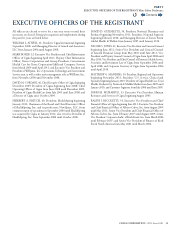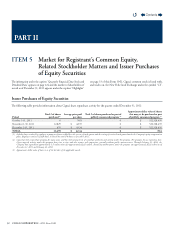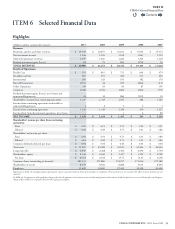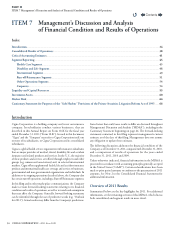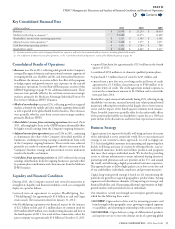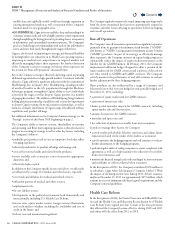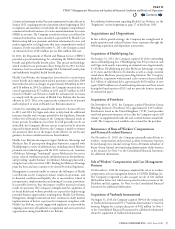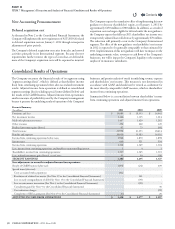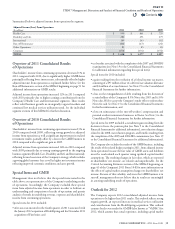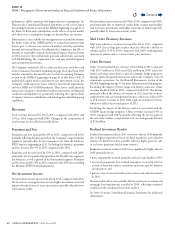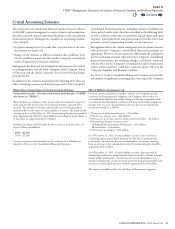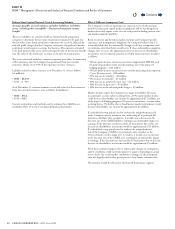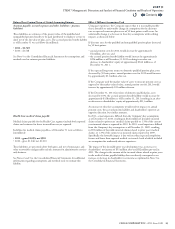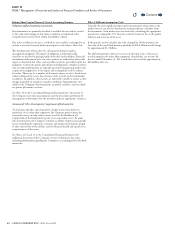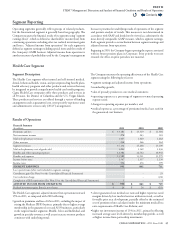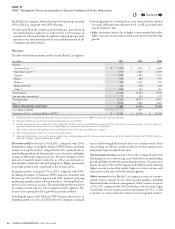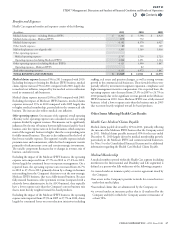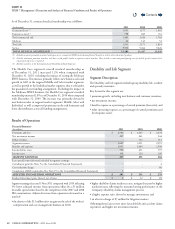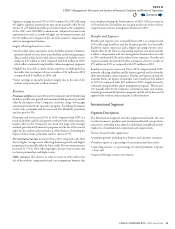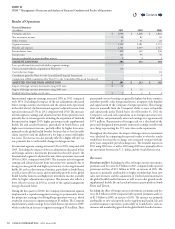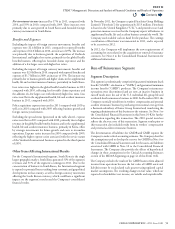Cigna 2011 Annual Report Download - page 63
Download and view the complete annual report
Please find page 63 of the 2011 Cigna annual report below. You can navigate through the pages in the report by either clicking on the pages listed below, or by using the keyword search tool below to find specific information within the annual report.
41CIGNA CORPORATION2011 Form10K
PART II
ITEM 7 Management’s Discussion and Analysis of Financial Condition and Results of Operations
Critical Accounting Estimates
e preparation of consolidated nancial statements in accordance
with GAAP requires management to make estimates and assumptions
that aect reported amounts and related disclosures in the consolidated
nancial statements. Management considers an accounting estimate
to be critical if:
•
it requires assumptions to be made that were uncertain at the time
the estimate was made; and
•
changes in the estimate or dierent estimates that could have been
selected could have a material eect on the Company’s consolidated
results of operations or nancial condition.
Management has discussed the development and selection of its critical
accounting estimates with the Audit Committee of the Company’s Board
of Directors and the Audit Committee has reviewed the disclosures
presented below.
In addition to the estimates presented in the following table, there are
other accounting estimates used in the preparation of the Company’s
consolidated nancial statements, including estimates of liabilities for
future policy benets other than those identied in the following table,
as well as estimates with respect to goodwill, unpaid claims and claim
expenses, postemployment and postretirement benets other than
pensions, certain compensation accruals, and income taxes.
Management believes the current assumptions used to estimate amounts
reected in the Company’s consolidated nancial statements are
appropriate. However, if actual experience diers from the assumptions
used in estimating amounts reected in the Company’s consolidated
nancial statements, the resulting changes could have a material
adverse eect on the Company’s consolidated results of operations,
and in certain situations, could have a material adverse eect on the
Company’s liquidity and nancial condition.
See Note2 to the Consolidated Financial Statements for further
information on signicant accounting policies that impact the Company.
Balance Sheet Caption/Nature of Critical Accounting Estimate Eect if Dierent Assumptions Used
Future policy benets – Guaranteed minimum death benets (“GMDB”
also known as “VADBe”)
ese liabilities are estimates of the present value of net amounts expected
to be paid, less the present value of net future premiums expected to be
received. e amounts to be paid represent the excess of the guaranteed
death benet over the values of contractholders’ accounts. e death benet
coverage in force at December31,2011 (representing the amount payable if
all of approximately 480,000 contractholders had submitted death claims as
of that date) was approximately $5.4billion.
Liabilities for future policy benets for these contracts as of December31
were as follows (inmillions):
•2011 – $1,170
•2010 – $1,138
Current assumptions and methods used to estimate these liabilities are
detailed in Note6 to the Consolidated Financial Statements.
Based on current and historical market, industry and Company-specic
experience and management’s judgment, the Company believes that it is
reasonably likely that the unfavorable changes in the key assumptions and/
or conditions described below could occur. If these unfavorable assumption
changes were to occur, the approximate after-tax decrease in shareholders’
net income would be as follows:
•5% increase in claim mortality rates – $30million
•10% decrease in lapse rates – $20million
•10% increase in election rates for future partial surrenders – $2million
•50basis point decrease in interest rates:
- Unhedged Mean Investment Performance – $20million
- Discount Rate – $30million
•10% increase in volatility – $20million
As of December31,2011, if contractholder account values invested in
underlying equity mutual funds declined by 10% due to equity market
performance, the after-tax decrease in shareholders’ net income resulting
from an increase in the unhedged provision for partial surrenders would be
approximately $5million.
As of December31,2011, if contractholder account values invested in
underlying bond/money market mutual funds declined by 3% due to bond/
money market performance, the after-tax decrease in shareholders’ net
income resulting from an increase in the provision for partial surrenders and
an increase in unhedged exposure would be approximately $10million.
e amounts would be reected in the Run-o Reinsurance segment.
Contents
Q


